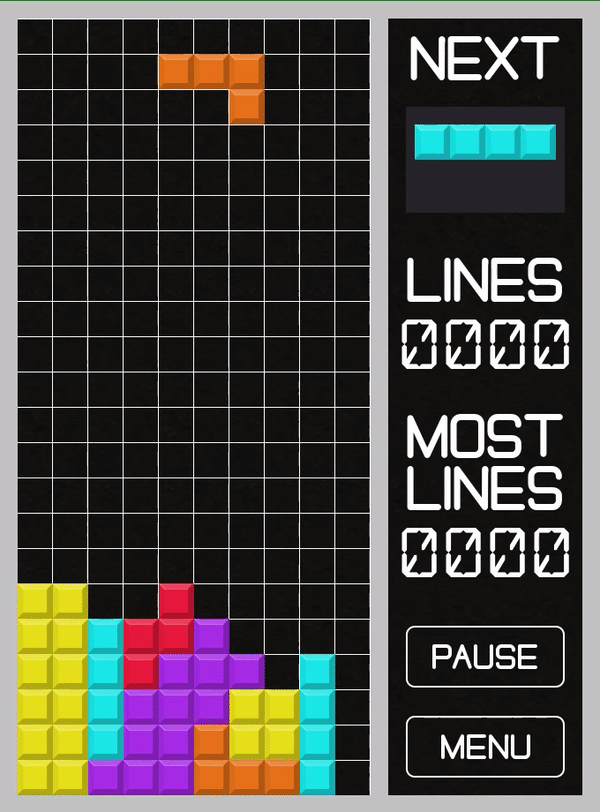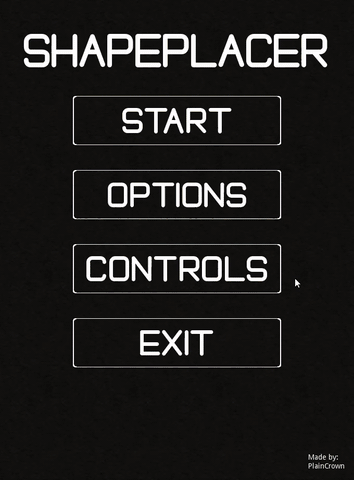ShapePlacer Postmortem
ShapePlacer 1.3.0
Postmortem - 2020/02/03
I'm PlainCrown, the creator of ShapePlacer—my third game! Now that the project is finished, it's time to reflect on what went right, what went wrong, and to learn from my mistakes.
Production:
The production began on August 16, 2019. Initially, I had no clue how to even begin making a tetris clone. After several failed attempts and scouting GitHub for tetris clones made by others, I finally found some decent examples to base my own version on. Even reaching the point where I could make a shape drop took a while.

The most annoying part of the project was figuring out how to make all of the filled lines disappear no matter what—including when the long piece is used to clear two lines at the top and the bottom, with two unfilled lines in-between. Clearing lines was far more challenging than I expected. After dealing with many unforeseen problems and bugs, I finally released the project under the name Tetris on September 22, 2019.

That was supposed to be the end of the project, but I soon changed my mind. After releasing Tetris 1.0.0 I decided to return to my first game—BlockCrasher—and give it some much needed features, as well as fix a couple of bugs that I couldn't solve beforehand. Then I felt the temptation to do the same with my snake and tetris clones. So I returned to Tetris on the first day of 2020 and began adding more features. Shape color customization was the first big addition.

With version 1.1.0, I renamed the game to ShapePlacer and went on to add a fast mode, an invisible mode, a secondary shape in the queue and a bunch of other improvements. The last update was published on January 20, 2020 and offered a far better version of tetris than my initial 1.0.0 release.
What went right:
- Determination. ShapePlacer was my most challenging project so far and I was tempted to quit many times along the way. It took a lot of willpower to continue working on the game despite feeling like I don't have the knowledge necessary to finish the project.
- Feedback. I received quite a lot of feedback from players and social media followers. Several cool features, such as the invisible mode, would probably never be added to the project without the suggestions made by others.
What went wrong:
- Time. This project was a much bigger time investment than I hoped for. Perhaps becoming better at programming will speed up my projects in the future but creating ShapePlacer took me roughly 56 days in total, which is way too much time for a simple tetris clone.
- Enjoyment. Due to regular bugs and other problems, I was frustrated rather than excited to work on ShapePlacer most of the time. This project really got under my skin, although I'm very pleased with the end result.
Conclusion:
ShapePlacer has been a good learning experience, and learning how to make something similar to tetris was the goal of the project, so it's still a success in my book despite all the difficulties along the way. I think that my self-doubt and frustration got in the way of finishing the project at a reasonable speed more than my lack of programming experience. I should learn to put more time and focus into solving my problems instead of worrying about them.
Get ShapePlacer
ShapePlacer
Fill up lines to gain score and don't let the shapes reach the top.
| Status | Released |
| Author | PlainCrown |
| Tags | 2D, classic, Godot, Minimalist, Pixel Art, Retro, shapeplacer, Singleplayer, Tetris, tetris-clone |
| Languages | English |
| Accessibility | Color-blind friendly, High-contrast |
More posts
- ShapePlacer 1.3.0Jan 20, 2020
- ShapePlacer 1.2.0Jan 11, 2020
- ShapePlacer 1.1.0Jan 06, 2020
Leave a comment
Log in with itch.io to leave a comment.